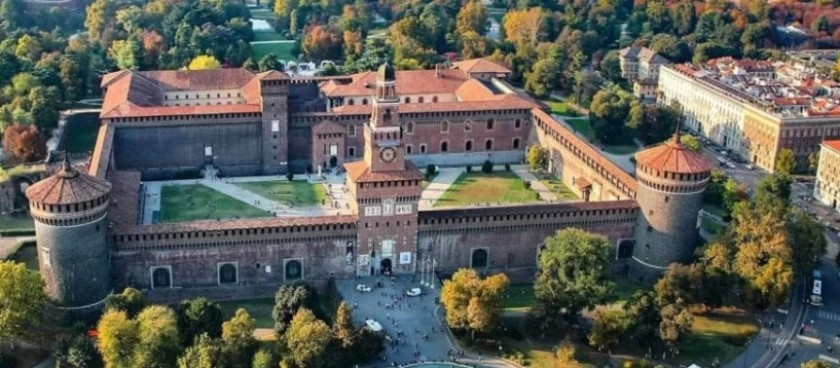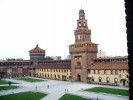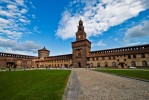- #IT30
- Piazza Castello, 20121 Milano MI, Italy
- +390288463700
- https://www.milanocastello.it/
- Working hours*:
Daily:
7:30 - 19:00 - * - opening and closing times as well as entrance prices, are subject to alterations without notice. Visitors are advised to check before visiting.
- 45.4706718, 9.1793647 Copy to clipboard Copy
-
#Castles
The Castello Sforzesco is in Milan, northern Italy. It was built in the 15th century by Francesco Sforza, Duke of Milan, on the remnants of a 14th-century fortification. Later renovated and enlarged, in the 16th and 17th centuries it was one of the largest citadels in Europe. Extensively rebuilt by Luca Beltrami in 1891–1905, it now houses several of the city's museums and art collections.
History
The original construction was ordered by Galeazzo II Visconti, a local nobleman, in 1358 – c. 1370;[1] this castle was known as the Castello di Porta Giova (or Porta Zubia), from the name of a gate in walls located nearby.[2] It was built in the same area of the ancient roman fortification of Castrum Portae Jovis, which served as castra pretoria when the city was the capital of the Roman Empire. It was enlarged by Galeazzo's successors, Gian Galeazzo, Giovanni Maria and Filippo Maria Visconti, until it became a square-plan castle with 200 m-long sides, four towers at the corners and up to 7-metre-thick (23 ft) walls. The castle was the main residence in the city of its Visconti lords, and was destroyed by the short-lived Golden Ambrosian Republic which ousted them in 1447.
In 1450, Francesco Sforza, once he had shattered the republicans, began reconstruction of the castle to turn it into his princely residence. In 1452 he hired the sculptor and architect Filarete to design and decorate the central tower, which is still known as the Torre del Filarete. After Francesco's death, the construction was continued by his son Galeazzo Maria, under the architect Benedetto Ferrini. The decoration was executed by local painters. In 1476, during the regency of Bona of Savoy, the tower bearing her name was built.
In 1494 Ludovico Sforza became lord of Milan, and called on numerous artists to decorate the castle. These include Leonardo da Vinci (who frescoed several rooms, in collaboration with Bernardino Zenale and Bernardino Butinone) and Bramante, who painted frescoes in the Sala del Tesoro; the Sala della Balla was decorated with Francesco Sforza's deeds. Around 1498, Leonardo worked at the ceiling of the Sala delle Asse, painting decorations of vegetable motifs. In the following years, however, the castle was damaged by assaults from Italian, French and German troops; a bastion, known as tenaglia, was added, perhaps designed by Cesare Cesariano. After the French victory in the Battle of Marignano in 1515, the defeated Maximilian Sforza, his Swiss mercenaries, and the cardinal-bishop of Sion retreated into the castle. However, King Francis I of France followed them into Milan, and his sappers placed mines under the castle's foundations, whereupon the defenders capitulated. In 1521, in a period in which it was used as a weapons depot, the Torre del Filarete exploded. When Francesco II Sforza returned briefly to power in Milan, he had the fortress restored and enlarged, and a part of it adapted as residence for his wife, Christina of Denmark.
Under the Spanish domination which followed, the castle became a citadel, as the governor's seat was moved to the Ducal Palace (1535). Its garrison varied from 1,000 to 3,000 men, led by a Spanish castellan. In 1550 works began to adapt the castle to modern fortification style, as a hexagonal (originally pentagonal) star fort, following the addition of 12 bastions. The external fortifications reached 3 km in length and covered an area of 25.9 hectares. The castle also remained in use as a fort after the Spaniards were replaced by the Austrians in Lombardy.
Most of the outer fortifications were demolished during the period of Napoleonic rule in Milan under the Cisalpine Republic. The semi-circular Piazza Castello was constructed around the city side of the castle, surrounded by a radial street layout of new urban blocks bounded by the Foro Buonoparte. The area on the "country" side of the castle was laid out as a 700-by-700-metre (2,300 by 2,300 ft) square parade ground known as Piazza d'Armi.
After the unification of Italy in the 19th century, the castle was transferred from military use to the city of Milan. Parco Sempione, one of the largest parks in the city, was created on the former parade grounds.
The government of Milan undertook restoration works, directed by Luca Beltrami. The Via Dante was cut through the medieval street layout in the 1880s to provide a direct promenade between the castle and the Duomo on an axis with the main gate. Between 1900 and 1905 the Torre del Filarete was rebuilt, on the basis of 16th-century drawings, as a monument to King Umberto I.
Allied bombardment of Milan in 1943 during World War II severely damaged the castle. The post-war reconstruction of the building for museum purposes was undertaken by the BBPR architectural partnership.


